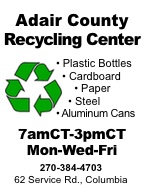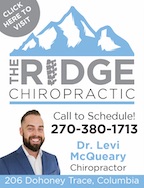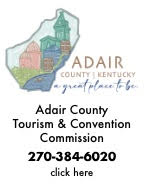| ||||||||||
Dr. Ronald P. Rogers CHIROPRACTOR Support for your body's natural healing capabilities 270-384-5554 Click here for details 


Columbia Gas Dept. GAS LEAK or GAS SMELL Contact Numbers 24 hrs/ 365 days 270-384-2006 or 9-1-1 Call before you dig Visit ColumbiaMagazine's Directory of Churches Addresses, times, phone numbers and more for churches in Adair County Find Great Stuff in ColumbiaMagazine's Classified Ads Antiques, Help Wanted, Autos, Real Estate, Legal Notices, More... 
|
October is National Pedestrian Safety Month From Marla Marrs Frankfort, KY - Gov. Andy Beshear, who has made public health and safety a top priority of his administration, is encouraging Kentuckians to work together to ensure our roadways are safe for everyone. "October is National Pedestrian Safety Month, and we're asking everyone to do their part to watch out for each other on the roads," said Gov. Beshear. "If drivers and pedestrians alike look out for one another, we can help ensure everyone gets home safely." The Kentucky Transportation Cabinet's (KYTC) Office of Highway Safety (KOHS) is partnering with the National Highway Traffic Safety Administration (NHTSA) to promote safe driving and walking tips throughout October. Staying alert is especially important as the end of Daylight Saving Time approaches and nightfall comes earlier. According to NHTSA, most crash-related pedestrian fatalities occur at night. Of 121 pedestrian deaths in Kentucky last year, 91 occurred after dark. So far this year, there have been 75 pedestrian deaths, 56 of which occurred after dark. "Practicing mindful behaviors like staying off your phone while driving or walking can prevent numerous tragedies on Kentucky's roads," said KYTC Secretary Jim Gray. "We are dedicated to creating a transportation network that prioritizes safety, inclusivity and accessibility for everyone who uses it." Streets, roads and highways were originally designed around cars and trucks. In 2022, Gov. Beshear announced the publication of the "Complete Streets, Roads and Highways Manual" produced by KYTC. The manual provides guidance, recommendations and resources to transportation organizations and agencies on prioritizing safety for all road users - motorists, motorcyclists, transit riders, bicyclists and pedestrians. A "complete street" is safe and accommodating for all users. Its design can vary according to land use, corridor characteristics and types of travelers who are expected to use it. Implementation may include a dedicated space for pedestrians and cyclists, such as bike lanes (or wide, paved shoulders), sidewalks, crosswalks, median islands, accessible pedestrian signals, roadway reconfigurations and roundabouts. The KOHS and NHTSA recommend the following behaviors to improve safety for all road users: Motorists:
Pedestrians:
This story was posted on 2024-10-03 09:12:00
Printable: this page is now automatically formatted for printing.
Have comments or corrections for this story? Use our contact form and let us know. More articles from topic News:
Genealogy & History Research Center Statistics to date Pumpkin Festival schedule of events on Saturday Old Glory - Flag History and Care Groundbreaking for new fitness center Festival at Giles House in Knifley is Saturday, Oct 5 Homemaker Recruitment Event on Oct 14 Remembering Habitat for Humanity home in Columbia Pumpkin Festival is Saturday in Edmonton Adair Co. Homecoming during Downtown Days, Oct 11-12 Silent City Tour 2024 will be October 14 View even more articles in topic News |



|
||||||||
|
| ||||||||||
|
Quick Links to Popular Features
Looking for a story or picture? Try our Photo Archive or our Stories Archive for all the information that's appeared on ColumbiaMagazine.com. | ||||||||||
|
Contact us: Columbia Magazine and columbiamagazine.com are published by Linda Waggener and Pen Waggener, PO Box 906, Columbia, KY 42728. Please use our contact page, or send questions about technical issues with this site to webmaster@columbiamagazine.com. All logos and trademarks used on this site are property of their respective owners. All comments remain the property and responsibility of their posters, all articles and photos remain the property of their creators, and all the rest is copyright 1995-Present by Columbia Magazine. Privacy policy: use of this site requires no sharing of information. Voluntarily shared information may be published and made available to the public on this site and/or stored electronically. Anonymous submissions will be subject to additional verification. Cookies are not required to use our site. However, if you have cookies enabled in your web browser, some of our advertisers may use cookies for interest-based advertising across multiple domains. For more information about third-party advertising, visit the NAI web privacy site.
| ||||||||||
















































